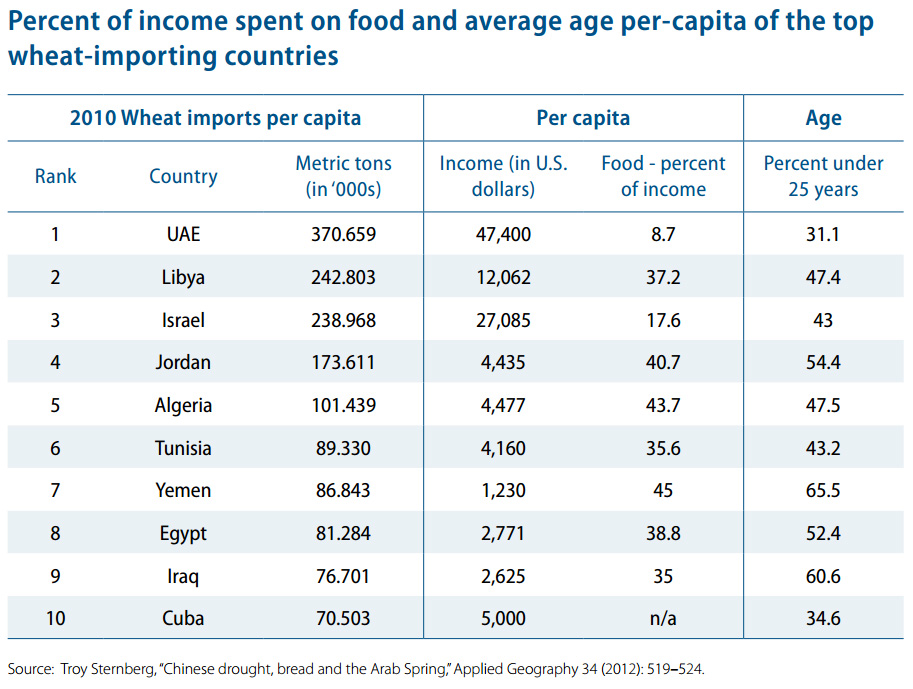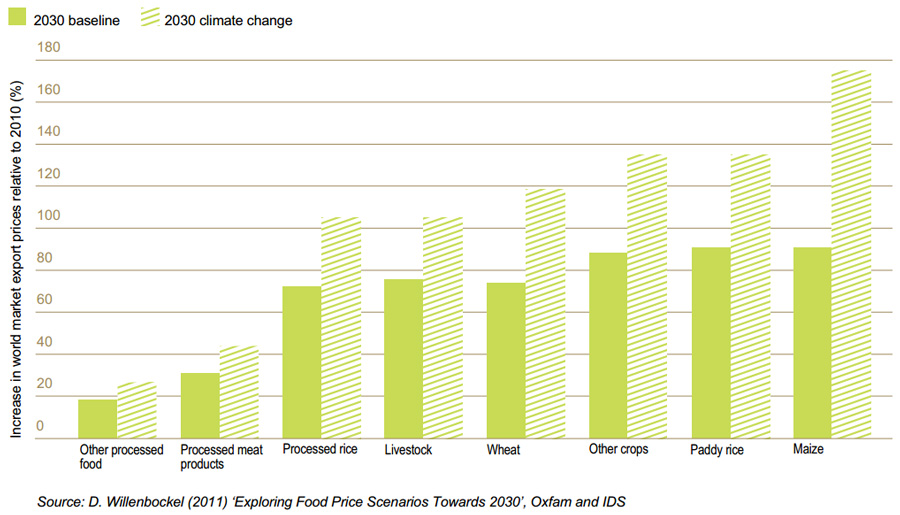-
Spring Thaw: What Role Did Climate Change and Natural Resource Scarcity Play in the Arab Spring?

Several high-profile reports in the last few months have suggested that climate change and natural resource scarcity contributed to the events that have rocked the Middle East and North Africa (MENA) since December 2010. Thomas Friedman is apparently working on a Showtime documentary about the topic. But what exactly was the role of environmental factors in the mass movement?
According to the authors of The Arab Spring and Climate Change, a series of essays edited by Caitlin E. Werrell and Francesco Femia and jointly published by the Center for American Progress, Stimson Center, and Center for Climate and Security, while political uprisings in Tunisia, Egypt, Libya, Syria, and elsewhere were a direct response to oppressive governments and social dissatisfaction, climate change may have acted as a “threat multiplier,” further exacerbating the underlying causes of revolution.
“Global warming may not have caused the Arab Spring, but it may have made it come earlier,” write Sarah Johnstone and Jeffrey Mazo of the International Institute for Strategic Studies in one essay.
Another report, Underpinning the MENA Democratic Transition, published by E3G, cautions that economic shocks driven by climate change and resource scarcity in the region could challenge fledgling democracies. “Failing to invest in preventive measures now will generate future risks that require additional government capacity to manage,” they write.
“Ag-flation”
“The world is entering a period of ‘ag-flation,’ or inflation driven by rising prices for agricultural commodities,” warn Johnstone and Mazo.
Egyptians, for example, depend on bread for one-third of their caloric intake and spend an average of 38 percent of their income on food, writes Troy Sternberg of Oxford University in The Arab Spring and Climate Change, but the country’s arid climate and poor resource management means it cannot produce enough wheat for domestic demand. As a result, Egypt is the world’s largest wheat importer, buying 9.8 million metric tons in 2010.
In the winter of 2010 and 2011, China – the world’s largest wheat producer – was struck by a “once-in-a-century” drought. At the same time, wheat production in Russia, Ukraine, and Canada also fell dramatically due to drought, wildfires, and abnormal cold (Canada). With global wheat supplies constricted, the Egyptian government failed to balance subsidies and market prices with public needs. According to research by Johnstone and Mazo, at the time of the uprisings in early 2011, food prices had increased by 20 percent, and 40 million Egyptians – about half of the population – were receiving food rations.
“We have reached the point where a regional climate event can have a global extent,” writes Sternberg. Nine of the top ten wheat-importing countries per capita in the world are in the Middle East, and seven of those countries experienced violent political protests in 2011.
“The failure by governments in the region to ensure their citizens’ food security during the 2010 price spike undermined any residual legitimacy of regimes rife with corruption and unable to effectively address poverty and unemployment,” Nick Mabey and his co-authors write in Underpinning the MENA Democratic Transition.
Reducing the Vulnerability of New Democracies
Climate change not only contributed to the timing of the Arab Spring, argue Mabey et al., but it may also impede the spread of democracy moving forward.
While international attention has been focused on building democratic institutions, stabilizing living standards should be a higher priority, they write. New democracies are especially vulnerable to economic shocks, and, as demonstrated by the events of 2010 and 2011, livelihoods in Middle East and North Africa are uniquely affected by climate change and food price spikes. Investments in energy, water, and food security therefore have the potential to have outsized effects on living standards and in turn the chances of democracy surviving, they argue.
Why is the region so vulnerable? Because in addition to the environmental challenges already present, especially drastic changes in resource availability are projected for the near future:
Tunisia, for example, will see a decrease in available drinking water of 30 percent by 2030; increases in the likelihood of crop season failure of over 50 percent by 2050; and over five percent of its population would be impacted by a one meter sea level rise. Egypt’s concentration of industry and population in the Nile Delta makes it the third most vulnerable developing country in the world to sea level rise. There are also potential risks from international disputes over the Nile Basin management as water flows become more volatile and upstream countries drier due to climate change. … Modeling suggests that major import crops like wheat are likely to increase in price by up to 80 percent by 2030 due to growing global demand; climate change could increase prices by a further 40 percent.
To support democracy, Mabey et al. write, “development strategies in the region need to focus more strongly on building economic and social resilience alongside broader-based economic growth.”
Water and Migration in Syria and Libya
In Syria, drought, crop failure, and internal displacement helped mobilize the opposition movement to the brutal regime of Bashir al-Assad, argue Femia and Werrell in The Arab Spring and Climate Change.
From 2006 to 2011, Syria experienced what one expert called “the worst long-term drought and most severe set of crop failures since agricultural civilizations began in the Fertile Crescent many millennia ago.” A UNDP report found that nearly 75 percent of farmers in northeastern Syria experienced total crop failure and herders lost 85 percent of their livestock. Another United Nations report found that more than 800,000 Syrians “lost their entire livelihoods” as a result of the droughts.
The reduction of Syria’s farm and herding land resulted in a rural-to-urban migration movement that put “significant strains on Syria’s economically depressed cities, which incidentally have their own water-infrastructure deficiencies,” write Femia and Werrell. Displaced farmers also have to compete for access to employment, housing, and resources with the more than 260,000 Iraqi refugees residing in Syria – and now the more than 2.5 million Syrians displaced as a result of the civil war.
However, Syria’s scarcity issues are not just climate-induced. “The Assad regime has, by most accounts except its own, criminally combined mismanagement and neglect of Syria’s natural resources, which has contributed to water shortages and land desertification,” write Femia and Werrell. For example, they point out that the number of well-tapping aquifers in the country jumped from 135,000 in 1999 to 213,000 by 2007, which has led to over-pumping in much of the country and drastically reduced groundwater supplies.
“As previously fertile lands turn to dust,” they write, “farmers and herders have had no choice but to move elsewhere, starve, or demand change.”
Water may be key in Libya too. Data from 2009 showed that Libyans had access to only 95.8 cubic meters of freshwater per capita, remarkably lower than the regional average of 400 cubic meters and dramatically lower than the global average of 6,258 cubic meters per capita.
Libya has a large migrant population of nearly 700,000 – roughly 10 percent of the total population – many of whom have emigrated from sub-Saharan Africa and the Sahel because of environmental issues in their homelands.
In the post-Qaddafi era, Femia and Werrell stress the urgency of developing a water-resource management program: “It may be the less overtly political issues such as climate change and water-resource management that hold the key to building unity,” they write.
Taking the Environment Into Consideration
The ultimate drivers of the Arab Spring were decades of disenfranchisement and depressed human potential by autocratic governments. But why the movement started when it did – which took many by surprise – is still unanswered.
Richard Cincotta on what demography says about the Arab Spring and democracy Femia and Werrell make the case that the interaction between climate change and food prices played an important role in that respect. While the Arab Spring “has a multitude of ultimate and proximate causes,” they write, “it is increasingly clear that global and regional climatic changes have played a role in multiplying stress in the region, and that the consequences of climate change will have to be properly addressed by the affected governments, as well as the international community, as these Arab nations rebuild.”
Mabey et al. as well as David Michel and Mona Yacoubian of the Stimson Center in The Arab Spring and Climate Change argue that addressing those resource vulnerabilities are key for the future.
“Creative strategies to address [economic and environmental strains] could both unlock sizeable potential for economic growth and job creation, and help mitigate mounting risks to essential ecosystems and natural resources, turning two of the region’s pre-eminent challenges into a significant opportunity,” write Michel and Yacoubian. For example, governments could finance retrofitting campaigns in urban centers to make buildings more energy efficient, which could “create four million jobs and pay for itself in two to seven years by trimming costly resource consumption.”
The Arab Spring has overturned the power structure of one of the most important geostrategic and fastest growing regions in the world. The support of major donors, governments, and development banks in the wake of revolutions and unrest has been substantial, but better targeting of those investments – to promote food and energy security and resilience to climate change as well – could allow them to go much further, strengthening gains in democratic governance and fostering continued change.
Sources: Assessment Capacities Project, Center for American Progress, Center for Climate and Security, E3G, Grist, IRIN News, Los Angeles Times, The New York Times, Oxfam, Stimson Center, UN Development Program, UN Office for Disaster Risk Reduction, UN Population Division.
Photo Credit: “Freedom,” courtesy of flickr user seven_resist. Charts: Troy Sternberg/The Arab Spring and Climate Change; Oxfam/E3G.
Topics: Africa, agriculture, climate change, conflict, democracy and governance, development, economics, Egypt, energy, environment, environmental security, featured, food security, foreign policy, Libya, livelihoods, Middle East, migration, natural resources, security, Syria, Tunisia, urbanization, video, water, youth
 A Publication of the Stimson Center.
A Publication of the Stimson Center.





